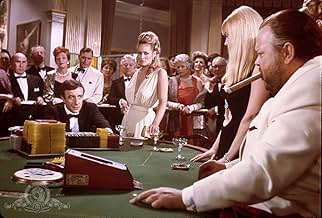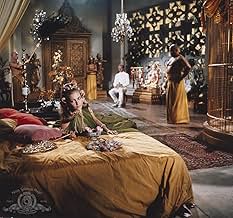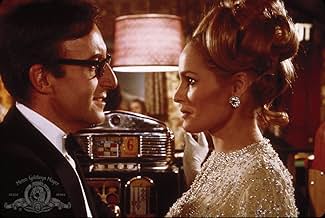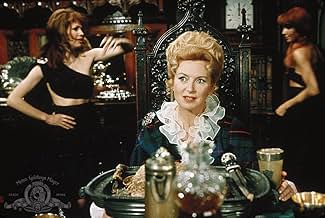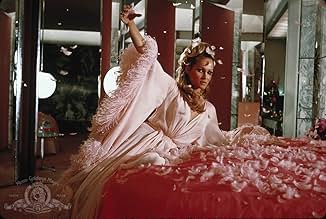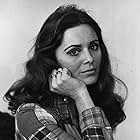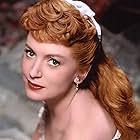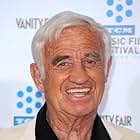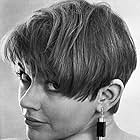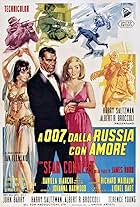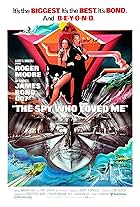James Bond esce dal pensionamento per una nuova avventura.James Bond esce dal pensionamento per una nuova avventura.James Bond esce dal pensionamento per una nuova avventura.
- Candidato a 1 Oscar
- 4 candidature totali
Jean-Paul Belmondo
- French Legionnaire
- (as Jean Paul Belmondo)
Trama
Lo sapevi?
- QuizPeter Sellers and Orson Welles hated each other so much that the filming of the scene where both of them face each other across a gaming table actually took place on different days with a double standing in for the other actor.
- BlooperIn the "vault" scene towards the end, Bond says, "Careful, it's vaporized lysergic acid, highly explosive". Lysergic acid, used in the synthesis of the hallucinogen LSD, is not explosive at all.
- Citazioni
Piper: Excuse me. Are you Richard Burton?
Evelyn Tremble: No, I'm Peter O'Toole!
Piper: Then you're the finest man that ever breathed.
- Curiosità sui creditiThe opening credit animation by Richard Williams parodies illuminated manuscripts with cartoon-style calligraphy. It sets the tone for the film as a psychedelic "knight's tale" of Sir James Bond.
- Versioni alternativeIn the Region 2 DVD which has English, German, French, Italian and Spanish audio tracks, the ending is left instrumental in Spanish audio track unlike the others.
- ConnessioniEdited into The Clock (2010)
Recensione in evidenza
Casino Royale has some outstanding elements. The production design is worth a 10. There are beautiful, often provocatively dressed or relatively undressed women everywhere you look. Many of its segments are funny; it's even occasionally hilarious.
The problem arose in putting all of it together. And with at least five directors and at least ten writers, it's not difficult to see why. The whole is a mess. There is little in the way of overarching plot. Most threads are just completely abandoned after awhile.
The story, which is very loosely based on Ian Fleming's James Bond novel Casino Royale (published in 1953--it's the first Bond novel), is a spoof of the typical adventure featuring the infamous secret agent. The real Bond (David Niven) went into retirement when his skills were at their peak. This Bond is quite different than the Bond we know--he is almost chaste, he's a homebody, he dedicates each evening's twilight to playing Debussy on the piano, and so on. Casino Royale has it that the Bond we know from other films is a decoy.
A group of older men, representing the secret agencies of the US, the UK, Russia and France, are on their way to the real Bond's home to ask for his assistance. It seems that someone has been trying to wipe out as many secret agents as they can. While they're pitching the idea of coming out of retirement to Bond, they're attacked. Bond's house is blown up, and he (implicitly) agrees to the assignment. Casino Royale is the story of the real Bond trying to get to the bottom of the sinister agent-wipeout plan. Part of carrying that out involves changing the identity of nearly every spy to James Bond--if the real Bond is to work unimpeded, he can't always be worrying about being killed by the criminal mastermind.
Each director worked on a different segment in relative isolation from the rest. This went so far as having their own portions of the script written. The problem was that despite Eon Productions (the production company behind most of the Bond films) not owning the rights to Casino Royale, they had used many of the "bits" in other Bond films. So there wasn't much of the book left to adapt. In addition, it was felt that a serious alternative Bond film couldn't compete against the Albert R. Broccoli/Harry Saltzman-produced films. So Casino Royale producers Jerry Bresler, John Dark and Charles K. Feldman had different writer/director teams create their own, parodic Bond segments that would be loosely tied together--it was almost a filmic version of the "Exquisite Corpse" game, in which you fold a piece of paper so that you can't see other persons' work, and you have to continue the drawing on your section with only a couple visual anchors.
Each segment features a different set of stars--the primary sets centering on Niven, Woody Allen, and Peter Sellers with Ursula Andress and Orson Welles. Those are all great actors, and great comedians in at least two cases. They all do a bit of their own schtick--in some cases, they demanded this. Woody does his neurotic New York Jew character, Peter Sellers rides the gray area between bumbling buffoon and suave playboy, with a couple generic Indian and Chinese impersonations thrown in for good measure, Orson Welles does his best Paul Masson Wine-pitching "elder statesman" demeanor, and also throws in a few of his more famous magic tricks. All of this stuff is good, but does it work as a unified film? No. And if that's not enough evidence for you, consider that the segments were further chopped up into set-pieces. There's the "M", or McTarry funeral stuff, the Niven car chase stuff, the Sellers/Andress romance stuff, and so on. Each set piece ends up being largely independent--you could almost see this as a series of skits on a similar theme. These facts make Casino Royale not quite work. It's certainly no match for a legitimate Bond film, despite the similarity of location-hopping, outrageous villains, spy gadgets and so on.
But, in isolation, the segments tend to be good to excellent. The stretch with Bond visiting the faux M widow is probably the funniest. It also presages the Sir Robin section of Monty Python and the Holy Grail (1975), but bests it in a way, if only because of its extension. The madcap ending of the film is a lot of fun for its embrace of absurdism as a supreme aesthetic disposition--and it may have even influenced some later films. And the segments with the trippiest visuals, both in the climax, are a fantastic treat for any fan of surrealism. They're good enough to watch the film just to see them. The production design is incredible throughout the film. Not just for the surrealism, but the lush Edwardian and Victorian interiors, complete with copies and works in similar styles to unique, influential artists such as Gustav Klimt and Otto Dix.
If we felt like being overly generous, we might be able to argue that the overarching mess of a plot was part of the point. This is a spoof of Bond, after all, and Bond novels and films tend to have sprawling plots--both geographically and narratively. We do travel to many exotic locales, meet many exotic people, doing exotic things, and we receive many plot intricacies and twists in both the typical Bond story and in Casino Royale. However, Bond films aren't quite convoluted or messy enough to deserve this kind of spoofing, so excusing the messiness of the whole to parodic intent seems an over-ambitious stretch.
Casino Royale is worth seeing, particularly if you're a big Bond fan or a big fan of any of the cast, or even if you just like a lot of late 1960s/early 1970s big, madcap comedies. Just don't expect anything like a tight story.
The problem arose in putting all of it together. And with at least five directors and at least ten writers, it's not difficult to see why. The whole is a mess. There is little in the way of overarching plot. Most threads are just completely abandoned after awhile.
The story, which is very loosely based on Ian Fleming's James Bond novel Casino Royale (published in 1953--it's the first Bond novel), is a spoof of the typical adventure featuring the infamous secret agent. The real Bond (David Niven) went into retirement when his skills were at their peak. This Bond is quite different than the Bond we know--he is almost chaste, he's a homebody, he dedicates each evening's twilight to playing Debussy on the piano, and so on. Casino Royale has it that the Bond we know from other films is a decoy.
A group of older men, representing the secret agencies of the US, the UK, Russia and France, are on their way to the real Bond's home to ask for his assistance. It seems that someone has been trying to wipe out as many secret agents as they can. While they're pitching the idea of coming out of retirement to Bond, they're attacked. Bond's house is blown up, and he (implicitly) agrees to the assignment. Casino Royale is the story of the real Bond trying to get to the bottom of the sinister agent-wipeout plan. Part of carrying that out involves changing the identity of nearly every spy to James Bond--if the real Bond is to work unimpeded, he can't always be worrying about being killed by the criminal mastermind.
Each director worked on a different segment in relative isolation from the rest. This went so far as having their own portions of the script written. The problem was that despite Eon Productions (the production company behind most of the Bond films) not owning the rights to Casino Royale, they had used many of the "bits" in other Bond films. So there wasn't much of the book left to adapt. In addition, it was felt that a serious alternative Bond film couldn't compete against the Albert R. Broccoli/Harry Saltzman-produced films. So Casino Royale producers Jerry Bresler, John Dark and Charles K. Feldman had different writer/director teams create their own, parodic Bond segments that would be loosely tied together--it was almost a filmic version of the "Exquisite Corpse" game, in which you fold a piece of paper so that you can't see other persons' work, and you have to continue the drawing on your section with only a couple visual anchors.
Each segment features a different set of stars--the primary sets centering on Niven, Woody Allen, and Peter Sellers with Ursula Andress and Orson Welles. Those are all great actors, and great comedians in at least two cases. They all do a bit of their own schtick--in some cases, they demanded this. Woody does his neurotic New York Jew character, Peter Sellers rides the gray area between bumbling buffoon and suave playboy, with a couple generic Indian and Chinese impersonations thrown in for good measure, Orson Welles does his best Paul Masson Wine-pitching "elder statesman" demeanor, and also throws in a few of his more famous magic tricks. All of this stuff is good, but does it work as a unified film? No. And if that's not enough evidence for you, consider that the segments were further chopped up into set-pieces. There's the "M", or McTarry funeral stuff, the Niven car chase stuff, the Sellers/Andress romance stuff, and so on. Each set piece ends up being largely independent--you could almost see this as a series of skits on a similar theme. These facts make Casino Royale not quite work. It's certainly no match for a legitimate Bond film, despite the similarity of location-hopping, outrageous villains, spy gadgets and so on.
But, in isolation, the segments tend to be good to excellent. The stretch with Bond visiting the faux M widow is probably the funniest. It also presages the Sir Robin section of Monty Python and the Holy Grail (1975), but bests it in a way, if only because of its extension. The madcap ending of the film is a lot of fun for its embrace of absurdism as a supreme aesthetic disposition--and it may have even influenced some later films. And the segments with the trippiest visuals, both in the climax, are a fantastic treat for any fan of surrealism. They're good enough to watch the film just to see them. The production design is incredible throughout the film. Not just for the surrealism, but the lush Edwardian and Victorian interiors, complete with copies and works in similar styles to unique, influential artists such as Gustav Klimt and Otto Dix.
If we felt like being overly generous, we might be able to argue that the overarching mess of a plot was part of the point. This is a spoof of Bond, after all, and Bond novels and films tend to have sprawling plots--both geographically and narratively. We do travel to many exotic locales, meet many exotic people, doing exotic things, and we receive many plot intricacies and twists in both the typical Bond story and in Casino Royale. However, Bond films aren't quite convoluted or messy enough to deserve this kind of spoofing, so excusing the messiness of the whole to parodic intent seems an over-ambitious stretch.
Casino Royale is worth seeing, particularly if you're a big Bond fan or a big fan of any of the cast, or even if you just like a lot of late 1960s/early 1970s big, madcap comedies. Just don't expect anything like a tight story.
- BrandtSponseller
- 31 mag 2005
- Permalink
I più visti
Accedi per valutare e creare un elenco di titoli salvati per ottenere consigli personalizzati
Dettagli
- Data di uscita
- Paesi di origine
- Lingue
- Celebre anche come
- Casino Royale
- Luoghi delle riprese
- Azienda produttrice
- Vedi altri crediti dell’azienda su IMDbPro
Botteghino
- Budget
- 12.000.000 USD (previsto)
- Lordo in tutto il mondo
- 2.783 USD
- Tempo di esecuzione2 ore 11 minuti
- Colore
- Proporzioni
- 2.39 : 1
Contribuisci a questa pagina
Suggerisci una modifica o aggiungi i contenuti mancanti

Divario superiore
By what name was James Bond 007 - Casino Royale (1967) officially released in India in English?
Rispondi

